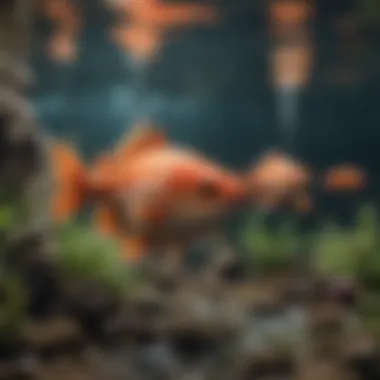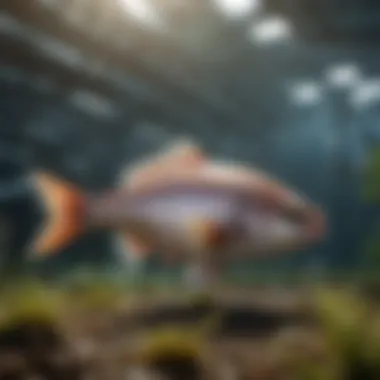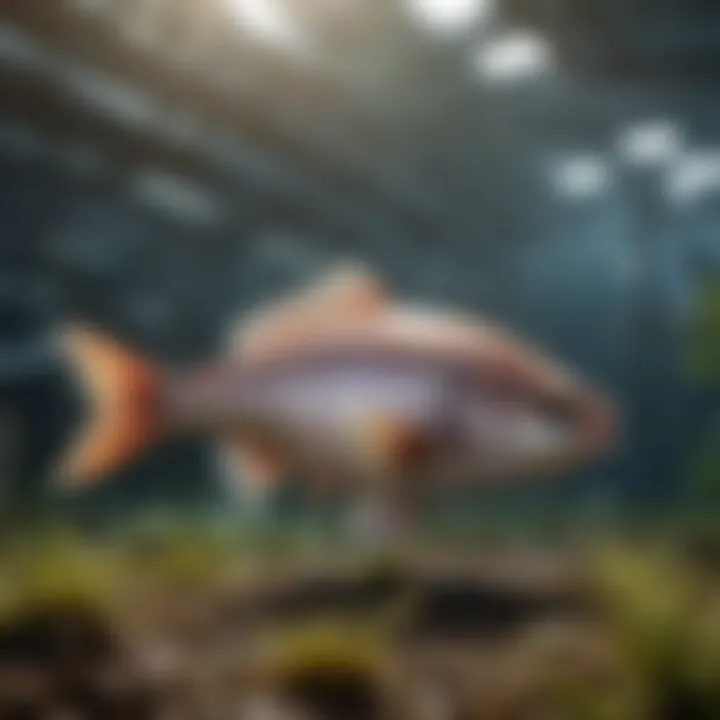Freshwater Fish Farming: Insights into Aquaculture


Intro
Freshwater fish farming, an integral part of aquaculture, plays a pivotal role in addressing global food demands. As population numbers rise, the need for sustainable protein sources becomes paramount. This distinctive form of fish farming enables the cultivation of various fish species in controlled freshwater environments, making it a reliable source of nutrition and economic opportunity.
Definition and Importance
At its core, freshwater fish farming involves breeding and raising fish in lakes, rivers, and ponds, or in constructed systems, such as tanks or recirculating aquaculture systems (RAS). This sector not only provides a sustainable source of food but also contributes significantly to livelihoods and economic development. Fish like tilapia, catfish, and trout have gained traction due to their growth rates and adaptability to farming environments.
The importance of these practices cannot be overstated. Given their contributions to food security and local economies, the ongoing exploration of sustainable fish farming methods and the integration of technology are crucial for the industry's future.
Brief History and Evolution
The journey of fish farming dates back thousands of years, with records indicating that the ancient Chinese cultivated carp in ponds around 4,700 BC. Fast forward to the 20th century, techniques have transformed dramatically, embracing scientific methods and technological innovations to enhance production and sustainability.
In the 1990s, the emergence of commercial aquaculture spearheaded a new era, shifting focus from wild catch to farm-raised fish. This transition has not only alleviated pressure on wild stocks but also addressed environmental concerns. As climate change and pollution issues loom over natural water bodies, freshwater fish farming stands as a beacon of hope, providing a controlled environment that promises better growth conditions and health management for aquatic species.
Understanding Freshwater Fish Farming
Freshwater fish farming is a crucial element of aquaculture that seeks to meet the growing demands for quality protein while balancing environmental considerations. This section delves into the fundamental underpinnings of this practice, spotlighting its significance in today’s agricultural landscape.
The practice of freshwater fish farming encompasses various techniques and methodologies. It operates within controlled environments, unlike wild stock fishing, which is largely unpredictable. By understanding these farming systems, practitioners and enthusiasts can foster greater efficiency and sustainability in production itself.
There’s much to ponder when it comes to the benefits of freshwater aquaculture. One might argue that it offers a stable source of food that presents lower risks in terms of overfishing. Additionally, properly managed fish farms can generate jobs and stimulate local economies. There’s a sense of responsibility here; when done right, this form of farming can contribute significantly to food security while also ensuring the preservation of wild fish populations.
Pest management, water quality, and nutrient balance are some intricacies that require thorough consideration. Each facet plays a pivotal role in shaping the success of farmed fish species. By dissecting these details, we can address some of the challenges that affect fresh waterways, ensuring our farming practices do not result in degradation of the ecosystem.
Defining Aquaculture and Its Importance
Aquaculture, at its core, refers to the cultivation of aquatic organisms, encompassing fish, crustaceans, mollusks, and aquatic plants. When we speak specifically of freshwater aquaculture, we are narrowing down to species like trout, catfish, and tilapia, which are intensively farmed due to their high market value and consumer preference.
The importance of aquaculture cannot be understated. As global populations burgeon, traditional fishing methods face the wrath of overexploitation and habitat destruction. This is where aquaculture steps in as a viable alternative, offering sustainability and reliability. Farming fish in controlled environments allows for consistent growth and health management, reducing the chances for elevated risks associated with fishing expeditions.
Incorporating advanced practices into aquaculture, such as recirculating systems, enhances water quality and reduces pollution, making it a more favorable option for the environment. The capacity to produce fish year-round also ensures that we can feed communities, particularly in regions where access to fresh fish is limited.
The Role of Freshwater Fish Farming in Food Security
Food security remains one of the pressing issues in agrarian communities worldwide. Freshwater fish farming plays an indispensable role in addressing this challenge. With an ability to produce high-quality protein at an efficient rate, fish farming can help bridge the nutritional gap present in many diets, particularly in developing parts of the world.
The benefits of freshwater fish farming extend beyond mere sustenance. It enables local economies to thrive by creating jobs and improving the livelihoods of farmers and their families. With a focus on local species, communities can cultivate fish that are well-suited to their ecosystems, enhancing both economic stability and dietary satisfaction.
Moreover, the scalability of freshwater fish farming means that practices can be tailored to fit small-scale operations run by families as well as large commercial enterprises. The diversity of farming structures—from simple ponds to elaborate recirculating systems—allows for flexibility in meeting market demands while still focusing on sustainability.
"Fish farming not only reduces pressure on wild stocks but also allows communities to build resilience against food shortages."
As the world continues to grapple with climate change and fluctuating food supply chains, the importance of integrating sustainable and efficient practices in freshwater fish farming becomes ever clearer. Keeping environmental and economic aspects in mind, it is crucial that stakeholders remain aligned in their efforts to enhance food security for generations to come.
Types of Freshwater Fish Species for Farming
In the diverse panorama of freshwater aquaculture, the selection of fish species stands as a cornerstone, shaping not only the economic viability of fish farming enterprises but the ecological health of the environments in which they operate. The choice of species can significantly influence growth rates, feed conversion ratios, and resilience to disease, making the understanding of these fish varieties essential for any aquaculture practitioner. Each species brings unique traits and challenges to the table, which ultimately affects food security, sustainability, and market demand in the long run.
Popular Fish Varieties for Aquaculture
Tilapia
Tilapia has earned a spot as one of the most widely farmed fish species across the globe. This fish is prized for its fast-growing nature and adaptability to varying environmental conditions. One key characteristic of tilapia is its ability to thrive in both freshwater and brackish water systems. This versatility makes it particularly attractive for farmers in regions where water quality may vary or where saltwater intrusion is a concern.
In terms of benefits, tilapia is known for its mild flavor and firm texture, making it a favorite among consumers. Its spawning and growth are rapid, leading to quicker returns on investment for farmers. However, managing tilapia can pose challenges; they can become invasive if released into the wild, and their welfare management often requires careful monitoring of water quality.
Catfish
Catfish, particularly the channel catfish, is another staple in freshwater fish farming. They are notorious for their hardiness and ability to grow well on a diet rich in plant-based feed. What sets catfish apart is their unique physiological feature of being able to breathe air, enabling them to thrive in low-oxygen environments. This adaptability can help farmers mitigate risks associated with fluctuating water conditions.
Moreover, catfish farming enjoys robust market demand due to their rich protein content and widespread culinary use. However, the costs associated with feed and disease management are important considerations for farmers looking to maximize their profits.
Trout
Trout species, particularly rainbow trout, are often seen as premium table fish. Their preference for cooler waters means that they require specific environmental conditions to thrive. One advantage is the high market value of trout, which can yield significant profits if successfully cultivated. Additionally, trout farming can be more sustainable in a controlled environment compared to wild fisheries.
Yet, trout farming presents its own set of challenges. They are susceptible to a variety of diseases and require high-quality feed, which can drive up operational costs. Moreover, proper water management is crucial to prevent stress and ensure quality production, making trout farming both an art and a science.
Cichlids
Cichlids, which include popular ornamental varieties such as the African cichlid, are a fascinating choice for farming enthusiasts. Their vibrant colors and diverse species add aesthetic value to aquaculture but also allow farmers to tap into the growing ornamental fish market. Cichlids are noted for their relative ease of breeding, providing opportunities for high yield.
Nonetheless, the market for cichlids can be tricky to navigate. Niche interests often lead to fluctuations in demand, and ensuring the right habitat conditions is vital, as cichlids tend to be territorial and delicate during breeding. The competition from both wild-caught and bred segments can also pose economic challenges.
Specialized Breeds and Their Benefits
Hybrid Strains
The innovation of hybrid strains has notably enhanced the income-generating potential of freshwater aquaculture. By combining the traits of two species, hybrid strains can be developed to optimize growth rates, feed efficiency, and disease resistance. This means farmers can achieve healthier stocks that mature faster.
Hybrid tilapia, for instance, show significant advantages, like higher biomass production and greater tolerance to varying water qualities, making them a prime choice in diverse farming systems. However, it is critical to source hybrids from reputable breeders to avoid issues related to fertility and adaptability.


Genetically Improved Varieties
Genetically improved varieties represent a leap forward in aquaculture. Through selective breeding, these varieties are engineered to enhance specific traits such as growth rate, disease resistance, and feed conversion efficiency. One significant benefit is the reduction in the need for antibiotics and other pharmaceuticals, which can have positive implications for both health and consumer preferences.
Nevertheless, adopting genetically improved strains involves considerable initial investment in breeding programs and can provoke regulatory scrutiny, which farms must navigate to remain compliant. As technology evolves, these varieties may offer greater economic advantages while aligning production with sustainability goals.
"The journey of understanding fish species in aquaculture is akin to a proverbial deep dive—each layer reveals unique adaptations, challenges, and opportunities that can influence both ecological balance and market dynamics."
In summary, selecting appropriate fish species for farming is not merely a matter of personal preference. Understanding the characteristics and requirements of various freshwater fish can lead to successful aquaculture operations that contribute positively to food security and environmental conservation.
Key Components of Freshwater Fish Farming Systems
Freshwater fish farming systems are the cornerstone of aquaculture, intertwining biological knowledge with engineering principles. Understanding these key components can spell the difference between a thriving operation and one that flounders. It encompasses everything from pond management to advanced technologies like recirculating systems, each aspect crucial for achieving an optimal environment for fish cultivation. Farmers and enthusiasts must grasp these elements thoroughly to navigate the complexities of fish farming successfully.
Pond Design and Management
Pond design and management are foundational to any freshwater fish farming operation. A well-designed pond not only optimizes growth conditions but also minimizes health issues among fish populations. When considering design, factors such as depth, size, location, and the natural landscape play pivotal roles.
Here’s what to think about:
- Depth and Surface Area: A good balance is needed. For example, ponds that are too shallow can heat up quickly, causing stress to fish.
- Water Source: Whether it comes from a river or a well, it should meet quality standards to avoid contamination.
- Aeration: Implementing aerators helps maintain dissolved oxygen levels, critical to fish survival.
Management practices should be just as meticulous. Regular monitoring of water quality parameters, adjustments based on fish growth stages, and maintaining natural flora and fauna are parts of routine care. A farmer must keep an eye on the pH levels, nitrate concentrations, and other related attributes to maintain a stable ecosystem.
Recirculating Aquaculture Systems (RAS)
Recirculating Aquaculture Systems, or RAS, represent a technological leap in fish farming, offering several advantages over traditional methods. This approach allows for the efficient reuse of water, significantly reducing waste and the need for freshwater resources.
Key benefits include:
- Water Efficiency: RAS uses 90% less water compared to conventional ponds, helping in areas where water scarcity is a concern.
- Control Over Environment: Farmers can meticulously control temperature and water quality, creating an optimal environment for fish.
- Reduced Disease Risk: Since fish are kept in a controlled environment, the spread of pathogens can be minimized.
However, RAS demands a higher initial capital investment and technical expertise. It introduces complexities in filter systems, oxygenation processes, and biological filtration, making it essential for operators to be knowledgeable and prepared.
Floating Systems and their Applications
Floating systems are another intriguing approach in freshwater aquaculture, incorporating buoyant structures to support fish farming. They are particularly useful in areas with limited land and can be utilized in lakes, reservoirs, and rivers. This method provides new opportunities, especially in urban settings.
Advantages of floating systems include:
- Space Optimization: These systems utilize space that’s often overlooked, such as open waters, reducing land competition.
- Improved Water Circulation: By floating, fish are closer to surface waters, which are typically better oxygenated.
- Flexibility: Farmers can relocate these systems based on environmental changes, such as seasonal flooding or changes in water temperature.
Despite these benefits, challenges exist, such as the need for more robust construction to withstand waves and potential predation from birds or other wildlife.
Nutritional Requirements for Cultured Fish
Understanding the nutritional requirements of cultured fish is paramount for successful farming operations. The health and growth of fish largely depend on a balanced diet that includes various essential nutrients. Ensuring that these requirements are met not only boosts the fish's growth rate but also enhances the quality of the final product, making it more appealing in the market. Without proper nutrition, fish can become susceptible to diseases, grow slowly, and yield less, which can have dire consequences on profitability and sustainability. Therefore, addressing the nutritional needs is not just a detail; it’s the backbone of any aquaculture endeavor.
Essential Nutrients and Supplements
Proteins
Proteins are the building blocks of life, serving as a vital component in the diets of all living organisms, including fish. Fish require high-quality proteins for optimal growth and maintenance. Proteins are particularly critical in early life stages, as they support muscle development and overall health.
One key characteristic of proteins is their amino acid profile, which must be complete for fish to thrive. For instance, some fish species might need specific amino acids, which are not always present in lower-quality feedstuffs. When selecting protein sources, it’s important to consider that high-quality sources like fish meal or soy protein offer a better amino acid profile and digestibility. However, the cost of high-quality protein may also pose a challenge for small-scale farmers.
In summary, while proteins are an essential diet component for cultured fish, ensuring high-quality sources is critical, balancing cost and nutritional value—a significant consideration in fish farming practices.
Vitamins
Vitamins play an indispensable role in the well-being of cultured fish as they regulate metabolic processes and strengthen immune responses. Each vitamin fulfills specific functions, and deficiencies can manifest in growth stunting or health issues. Common vitamins include A, D, E, and the B-complex group.
One noteworthy aspect of vitamins is their synergistic effects with other nutrients, which means that their effectiveness can be heightened when provided alongside other vitamins or minerals. For example, Vitamin C is essential for collagen synthesis and helps in disease resistance, making it a captain of the health ship in aquaculture.
The challenge, however, lies in ensuring these vitamins are not destroyed during the processing of feeds, which can significantly reduce their bioavailability. The encapsulation techniques and storage conditions are important factors to consider in this regard, as they directly impact the efficacy of the vitamins included in the fish diet.
Minerals
Minerals are fundamental to various physiological functions in fish, from maintaining osmotic balance to forming bones and teeth. Essential minerals include calcium, phosphorus, and magnesium, among others. Their presence influences various metabolic pathways, ensuring that fish develop properly and resist diseases.
A significant characteristic of minerals is their diversity in origin, as they can be derived from natural sources like limestone for calcium or synthetic supplements. However, not all sources are created equal. Some natural sources may come with impurities that can lead to negative outcomes in farming setups.
Another major consideration is that excessively high mineral levels can be detrimental, leading to metabolic disorders or even mortality in severe cases. Therefore, balancing the mineral content in fish feed is crucial to avoid any health repercussions while ensuring overall well-being and growth potential.
Feeding Regimens for Optimal Growth
Creating effective feeding regimens is an intricate dance that combines science and experience. Properly developed feeding schedules will ensure that fish receive consistent and high-quality nutrition that leads to healthy growth rates. Fish feeding practices should take into account species-specific needs, growth stages, and water quality factors. To achieve optimal growth, timing, frequency, and quantity of feed can all drastically influence outcomes. Here are some general practices:
- Align feed types with fish life stages (young vs. adult).
- Monitor feeding behavior; adjust amounts based on consumption rates.
- Employ feeding strategies such as scheduled feeding versus continuous feeding.
- Consider time of day, as certain species may feed better during dawn or dusk.
By integrating a structured feeding regimen, cultured fish farmers can maximize the growth potential of their stock while also managing resources effectively.
Environmental Considerations in Freshwater Aquaculture
Environmental considerations in freshwater aquaculture hold substantial weight, as they influence not only the success of fish farming practices but also the broader ecological health of surrounding ecosystems. Proper management of environmental factors ensures that production is sustainable and that it minimizes negative impacts on local water bodies and wildlife. An understanding of these considerations allows aquaculture practitioners to make informed decisions that enhance productivity while safeguarding the environment.


Ensuring a balance between fish farming and environmental preservation is critical. The integration of sustainable practices can lead to long-term benefits, such as reducing costs associated with water treatment, improving fish health, and maintaining biodiversity. Furthermore, consumers today are increasingly vigilant about the origins of their food, thus making environmental management a significant factor for marketability.
Water Quality Management
Water quality management is at the heart of successful aquaculture. It encompasses various parameters, including pH levels, dissolved oxygen, and turbidity.
pH Levels
The pH level in a freshwater fish farming setup is a critical aspect that affects fish health and growth. This measure indicates the acidity or alkalinity of the water. Ideally, most freshwater species thrive in a pH range between 6.5 and 9.0. If this range isn't maintained, it can stress fish, leading to poor growth or even mortality.
One of the key characteristics of pH levels is their sensitivity to environmental changes. For example, the presence of organic materials can lower pH levels, making water more acidic. Monitoring pH can reveal more than just the immediate health of the fish; it reflects the overall ecosystem’s status. A distinct advantage of maintaining proper pH levels means promoting a healthy breeding ground for beneficial microorganisms that assist in nutrient cycling. Conversely, neglecting this can breed disaster in a fish farm, where high acidity can lead to the leaching of toxins into the water, impacting not just fish but the entire aquatic community.
Dissolved Oxygen
Dissolved oxygen refers to the amount of oxygen available in water, and it plays a vital role in fish survival. Freshwater fish are particularly dependent on sufficient levels of dissolved oxygen, which should ideally stay above 5 mg/L for optimal health.
The presence of dissolved oxygen is crucial, as it supports respiration and metabolic processes in fish. The unique feature here is that it fluctuates based on several elements like water temperature, salinity, and biological activity. An advantage of regularly monitoring and managing dissolved oxygen is that it aids in ensuring fish farming efficiency, as low levels can lead to hypoxia, causing stress and death among stock. It is a popular focus because it directly relates to fish vitality and growth.
Turbidity
Turbidity, a measure of water clarity, is another significant factor in water quality management. High turbidity levels can interfere with light penetration, affecting aquatic plants' photosynthesis and thereby impacting the entire local ecosystem.
One characteristic of turbidity is its visibility — clear water usually means lower turbidity, whereas murky or cloudy water indicates potentially high turbidity, often caused by runoff or excessive feeding practices. The challenge with turbidity is that while some algae thrive in murky waters, it can create an inhospitable environment for fish. Regular checks and management strategies can clear up issues linked to turbid waters, fostering a healthier environment overall.
Impact of Aquaculture on Local Ecosystems
The influence of aquaculture on local ecosystems mustn't be overlooked. The introduction of farmed species can alter native fish populations, compete for resources, and even cause diseases to spread among wild fish.
As fish farms develop, there’s a risk of nutrient loading in nearby waterways due to excess feed and waste from farmed fish. This can lead to harmful algal blooms that not only affect aquatic life but can taint water supplies.
Moreover, habitat disruption can occur during the establishment of aquaculture facilities. This can lead to loss of biodiversity and degradation of natural habitats vital for various aquatic organisms. Thus, examining these impacts can guide sustainable practices that align the goals of aquaculture with ecosystem preservation.
"Water quality management stands as a cornerstone for successful aquaculture, influencing both productivity and environmental health."
Balancing productive aquaculture with the preservation of local ecosystems is no small feat. Thus, continual learning, adaptation, and monitoring form the bedrock of responsible freshwater fish farming.
Sustainable Practices in Freshwater Fish Farming
Sustainable practices in freshwater fish farming are no longer an optional add-on; they have become a necessary cornerstone of aquaculture. As the global demand for fish increases, ensuring that the methods used to farm fish do not negatively affect the environment grows increasingly important. Sustainable fish farming not only aims to preserve aquatic ecosystems but also contributes to the economic viability of fish farming operations in the long run.
The essence of sustainable practices is to foster a well-balanced synergy between fish production and ecological health. This means minimizing pollution, reducing water use, and creating habitats that support local biodiversity. By adopting sustainable methods, fish farmers can mitigate the risks associated with overfishing, habitat destruction, and climate change. The long-term benefits go beyond the environment; they also help safeguard the livelihoods of farmers, making ecological responsibility a wise business choice.
Strategies for Reducing Environmental Impact
Among the various strategies deployed to reduce the environmental impact of freshwater fish farming, several stand out:
- Efficient Water Use: The implementation of recirculating aquaculture systems allows for minimal water wastage by filtering and reusing water within the farm. This technology not only conserves water but also reduces the need for chemical treatments.
- Sustainable Feed Sources: Using feed made from plant-based ingredients rather than fish meal can significantly lessen the fishing pressure on wild stocks. For instance, incorporating by-products from other agricultural activities can also help in reducing waste.
- Integrated Multi-Trophic Aquaculture (IMTA): This practice involves cultivating different species together in a way that maximizes resource use. For example, fish can be raised alongside aquatic plants and shellfish, which can utilize the waste produced by the fish as nutrients.
- Local Sourcing: Whenever possible, sourcing materials from local suppliers can cut down on transportation emissions and support the community. It also fosters relationships that may provide additional support for sustainable farming initiatives.
Implementing these strategies does require an initial investment of time and resources. However, the long-term rewards, including healthier fish and a cleaner environment, are well worth it.
Certification Processes for Sustainable Practices
Ensuring that fish farming operations engage in sustainable practices can be greatly enhanced through certification. Several organizations offer certification programs that evaluate the practices of fish farms against rigorous sustainability standards. The following are key aspects surrounding certification processes:
- Standards and Guidelines: Certifications often have established criteria that farms must meet. These may include environmental protection, social responsibility, and economic viability. Meeting these standards is crucial for obtaining certification, which can boost a farm's credibility in the eyes of consumers.
- Transparency and Traceability: Certification bodies usually emphasize the importance of being transparent about production practices. This not only builds consumer trust but also encourages farms to maintain high standards consistently.
- Regular Audits: Obtaining certification doesn’t end at approval. Regular audits are a requirement to ensure ongoing compliance with established standards. This process encourages farms to stay proactive about their sustainability efforts.
- Consumer Awareness: With more consumers becoming concerned about the environmental impacts of their food choices, certifications serve as a critical signal of quality. Certifications like that from the Aquaculture Stewardship Council (ASC) or the Global Aquaculture Alliance (GAA) indicate to buyers that the fish they are purchasing have been raised sustainably.
"Sustainable fish farming is not just a trend; it’s a commitment to preserving the environment while meeting the needs of today and tomorrow."
Engaging in certification processes elevates a farm's market position and contributes significantly to the broader movement of responsible aquaculture. By making sustainability visible and verifiable, fish farms can play a vital role in the health of the aquatic ecosystem and global food security.
Economic Aspects of Freshwater Fish Farming
The economic dynamics surrounding freshwater fish farming are as layered as the waters from which the fish are harvested. This portion of the article seeks to illuminate the financial landscape of aquaculture, focusing on market trends, demand analysis, and strategic financial planning. Understanding the economic aspects is not only crucial for existing farm owners, but also for novices looking to embark on this sustainable venture. With the proper insights, fish farmers can cultivate a garden of opportunities in a sector increasingly dictated by consumer preferences and environmental sustainability.
Market Trends and Demand Analysis
In recent years, the market for freshwater fish has ballooned, buoyed by a growing appetite for sustainable protein sources among consumers. Tilapia, catfish, and trout are some of the most sought-after species, with their popularity driven by health trends favoring omega fatty acids and lean protein. The demand for farm-raised fish tends to fluctuate based on factors such as seasonal trends, health certifications, and even global events that may affect fishing quotas.
Farmers operating within this space need to stay on their toes. An understanding of consumer behavior is paramount. For instance, many fish consumers now favor brands that boast eco-friendly practices. This preference for sustainability is reflective of a wider social trend where quality takes precedence over quantity. These insights can significantly shape farming strategies, so keeping an ear to the ground—market research, consumer surveys, and even social media analysis—will prove invaluable.
- Increasing Demand Factors:
- Health consciousness among consumers.
- Sustainability and eco-friendly farming methods.
- Growth in food service sectors emphasizing locally sourced fish.
Cost-Benefit Analysis and Financial Planning
Economic prosperity in the realm of freshwater fish farming stems from systematic cost-benefit analyses. Knowing your costs helps avoid fishing in troubled waters. Initial investments can be substantial, covering everything from pond construction to feed and fish stock. However, a meticulous financial plan outlining both current expenses and projected revenues can provide a buoy for business longevity.
- Key Expenditures Include:
- Land and water resources,
- Feed and nutrition,
- Hatchery and health management,
- Labor.
On the flip side, revenue comes from diverse streams. Beyond the direct sales of fish, ancillary benefits such as pond management services or educational workshops can add to the bottom line. Farmers can further distinguish themselves by obtaining certifications that may allow them to command higher market prices.


"An astute financial plan not only covers the essentials but also paves the way toward innovative income sources."
Ultimately, recognizing both the challenging yet rewarding nature of the financial aspect of aquaculture can spell the difference between running a thriving operation or facing turbulent economic waters. In short, an informed approach to economic planning is prudent in navigating the complexities of freshwater fish farming.
Technological Innovations in Aquaculture
The aquaculture industry is undergoing a significant transformation, thanks to technological innovations that are reshaping how freshwater fish farming is conducted. Embracing technology is not merely about keeping up with trends; it’s about enhancing productivity, improving sustainability, and ensuring a better quality of fish. With challenges like environmental degradation and food security on the rise, these advancements play a pivotal role in addressing issues and contributing to a more resilient future for aquaculture.
Use of Biotechnology in Fish Breeding
Biotechnology has emerged as a game changer in fish breeding, allowing for more precise control over genetic qualities. Through various techniques like selective breeding, polyploidy, and gene editing, farmers can cultivate fish that grow faster, have higher stress resistance, and exhibit desirable traits. For instance, genetically improved varieties like the AquaAdvantage Salmon have been developed to reach market size faster than their non-GMO counterparts. This not only increases efficiency but also reduces the carbon footprint associated with prolonged farming cycles.
Considerations regarding ethical standards are paramount in this debate. As fish farming moves towards using biotechnological tools, it raises questions about biodiversity impacts and consumer acceptance. Careful regulation and transparency about breeding practices are essential to maintain trust among consumers and environmental advocates alike. This underscores the importance of responsible biotechnology.
Automation and Monitoring Systems
Automation is rapidly changing the face of aquaculture, and freshwater fish farms are no exception. Systems are being developed for feeding, monitoring water quality, and even managing fish health. For example, automated feeders can dispense the right amount of food at specified intervals, ensuring that fish receive optimal nutrition without overfeeding. This not only reduces waste but also promotes healthier fish growth.
Monitoring systems equipped with sensors keep track of crucial parameters such as pH levels, dissolved oxygen, and temperature. Such technology offers farmers near real-time data, enabling prompt adjustments to maintain ideal growing conditions. Just imagine a farmer receiving alerts directly on their smartphone about a drop in oxygen levels, ensuring immediate action to prevent stress or mortality in their stock.
Automation and monitoring processes can also enhance scalability, enabling smaller farms to efficiently compete with larger operations. However, while the benefits are pronounced, investments in technology require careful financial planning. The initial costs can be high, but the long-term savings and increased output often justify the expense.
"By adequately integrating technology, freshwater aquaculture can transition into a more sustainable and profitable industry, resolving some of the pressing issues it faces today."
In summary, the embrace of technological innovations in aquaculture represents not just a trend but a necessary evolution in the industry. As biotechnology and automation continue to refine freshwater fish farming practices, they promise to foster an environment where food security, sustainability, and economic viability go hand in hand.
Regulatory Framework and Compliance
The regulatory landscape surrounding freshwater fish farming is an essential facet of the overall aquaculture environment. It serves several purposes, primarily ensuring that farming practices remain sustainable, safe, and beneficial for both the producers and consumers. Awareness of regulatory frameworks helps fish farmers navigate the mazes of compliance, promoting responsible practices while also safeguarding the ecosystem. Below, we explore two critical areas: Licensing and Permitting Procedures, along with Policies Promoting Responsible Aquaculture.
Licensing and Permitting Procedures
Obtaining the correct licenses and permits is akin to laying a solid foundation for a house. Without these, everything built on top risks instability. In many regions, a system of licensing is mandated to ensure that both the quality of farmed fish and their environmental impact are monitored. A number of elements are involved in this process:
- Application Process: Farmers must often submit an application detailing their operations, which may include information about location, species raised, and planned farming methods.
- Fees: Licensing generally requires the payment of fees, which can vary based on the scale of operations and local regulations.
- Inspections and Compliance: Most licensing bodies conduct inspections to verify that farms meet all required regulations. Violations can result in penalties, including revocation of licenses.
- Public Input: In some areas, public input may be solicited prior to granting permits, allowing community members to voice concerns regarding potential environmental impacts or other issues.
The entire licensing framework not only enhances operational integrity but also builds public trust in the aquaculture industry. By being transparent about methods and regulatory compliance, farmers present themselves as credible players in food production.
Policies Promoting Responsible Aquaculture
Policies surrounding responsible aquaculture often serve as guiding principles that dictate how fish farming should be conducted. These policies aim to refreshingly align economic viability with environmental responsibility. Some key tenets include:
- Sustainability Standards: Regulations may require that farming practices minimize environmental impacts, such as ensuring that water quality remains stable and preventing overfishing.
- Fisheries Management Plans: Local authorities might develop strategies to manage fish populations and habitats effectively. This can involve catch limits or the designation of protected areas.
- Animal Welfare Regulations: Some policies impose standards for the welfare of fish, ensuring they are treated humanely throughout their life cycle. This includes considering factors such as stocking density and living conditions.
- Traceability Requirements: Many jurisdictions now include traceability requirements that allow the origin of farmed fish to be tracked through the supply chain, which can aid in maintaining quality and safety.
"A well-regulated aquaculture industry is essential to ensuring that future generations can enjoy the benefits of sustainable fish farming practices."
Understanding both licensing and policies provides farmers with a framework that encourages responsible practices while fostering growth. As the industry continues to evolve, compliance with these regulations is not just a legal obligation—it’s a moral one that speaks volumes about a farmer's commitment to sustainable aquaculture. According to Wikipedia, such adherence can significantly contribute to the long-term viability of freshwater fish farming.
Thus, grasping the regulatory framework allows fish farmers to position themselves strategically in a marketplace increasingly focused on sustainability and ethics. It’s not just about farming fish; it’s about creating a legacy that promotes healthy oceans—and that’s a concept worth swimming toward.
Challenges in Freshwater Fish Farming
In the ever-evolving arena of freshwater fish farming, understanding the challenges that come with it is absolutely crucial. The intricacies of this industry are not merely theoretical; they intersect significantly with the economic viability and sustainability of farming practices. Farmers grappling with these challenges can find both opportunities and pitfalls in varying degrees.
Disease Management and Prevention
When raising fish, disease management often takes center stage. Diseases can wipe out entire stocks if left unchecked, leading to tremendous financial losses. The signs of disease might not be immediately apparent, making early detection a challenge. Without careful monitoring, a farmer might find themselves in hot water—figuratively, of course.
To effectively manage the health of fish populations, aquaculture specialists recommend the following:
- Routine Health Checks: Regular examination helps in the early identification of potential disease outbreaks.
- Vaccination Programs: Vaccines can be an effective way to prevent specific diseases, reducing reliance on antibiotics and promoting healthier stock.
- Biosecurity Measures: Implementing strict biosecurity protocols helps minimize the chance of disease introduction into fish stocks. This includes maintaining cleanliness in the equipment and facilities.
"An ounce of prevention is worth a pound of cure." This age-old saying rings particularly true when it comes to fish farming, as attention to detail can save farmers a lot of trouble down the line.
Economic Viability in a Competitive Market
The economic landscape for freshwater fish farming is, without a doubt, rife with competition, and this can often lead to an uphill battle for margin preservation. Producers are constantly searching for ways to maximize output while keeping costs in check. In this environment, economic viability often hinges on innovation and adaptability.
Several key factors are essential for maintaining economic health in fish farming:
- Market Diversification: Relying on a single fish species can be risky. Farmers often benefit from diversifying their species selection to reduce risk and tap into different market demands.
- Cost Management: Keeping a close eye on production costs is integral. This includes energy sources, feed costs, and labor costs—anything that can be optimized will enhance profitability.
- Consumer Trends: Understanding shifting consumer preferences is vital. Farmers who keep their finger on the pulse regarding sustainability and health-conscious options can position themselves advantageously in the marketplace.
Moreover, establishing direct sales channels, such as farmer's markets or community-supported agriculture, can expand market access and improve financial outcomes. As fish farming continues to adapt to market demands, those willing to innovate and evolve have a better chance at long-term success.
Future Prospects of Freshwater Fish Farming
The landscape of freshwater fish farming is constantly shifting, influenced by various external factors that call for adaptability and innovation. With increasing global demand for sustainably sourced fish, addressing food security concerns has become more pressing. This section delves into the prospects that lay ahead for freshwater fish farming, highlighting the significance of expanding markets and the innovative practices that will shape its future.
Expanding Global Markets
As the world’s population continues to grow, so does the appetite for protein-rich food sources, particularly fish. The development of global markets for freshwater fish presents both challenges and opportunities for fish farmers. To thrive in this competitive arena, farmers must stay attuned to market trends and consumer preferences.
- Market Diversification: Freshwater fish farmers are not just catering to local markets anymore. The rise of e-commerce has opened the door to international sales, allowing farmers to reach consumers far beyond their immediate region. This means that specialized varieties or organic produce can now find buyers globally.
- Health-conscious Consumers: There is a palpable shift toward healthier eating habits. Fish is being globally recognized for its nutritional benefits, prompting farmers to adjust their production methods to meet the burgeoning demand for organic and ethically sourced seafood. Brands like Whole Foods have taken note, driving the trend of sourcing responsibly farmed fish.
- Aquaculture Export Potential: Countries that have invested in aquaculture technologies are well-positioned to export various fish species. Nations like Vietnam, which has a robust catfish farming sector, exemplify the economic gains that can be achieved. Exporting not only brings in revenue but also encourages sustainable practices as international markets often require certifications.
"The future is bright for those willing to adapt and innovate in the freshwater fish farming sector. Export opportunities abound, but it is the ability to pivot towards market demands that truly ensures success."
Innovative Practices Shaping the Industry
Innovations in technology and farming practices are not just optional; they are essentials for future success in freshwater fish farming. These advancements aim to enhance productivity while ensuring sustainability and economic viability.
- Embracing Technology: The incorporation of technology, like automated feeding systems and environmental monitoring tools, is becoming standard practice. These tools allow farmers to optimize feeding schedules and track water quality, promoting healthier fish and improving overall yield.
- Selective Breeding and Genetic Improvements: Utilizing biotechnological methods to create disease-resistant and faster-growing fish strains is becoming mainstream. These innovations increase productivity and can lead to reduced reliance on chemicals and antibiotics, which are often harmful to the environment.
- Diversified Aquaculture Systems: Innovations such as integrated multi-trophic aquaculture (IMTA) allow farmers to cultivate multiple species in a single ecosystem. For instance, by combining fish with shellfish and seaweeds, farmers can create a balanced ecosystem that maximizes resource use. This practice not only boosts profitability but also minimizes ecological footprint.



